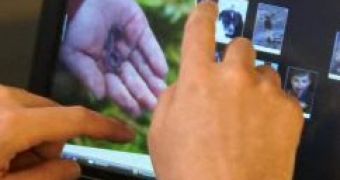One thing is clear, although starting from the summer of 2007 and ending in the first half of this year, the main focus for Microsoft has been building Windows Vista SP1, Windows XP SP3, in terms of the Windows client the company did much more than just service packs. In the background of Vista SP1 and XP SP3, Microsoft is putting together Windows 7. As the Redmond company's next iteration go, Windows made its debut at D6 - All Things Digital conference, with a presentation from Julie Larson-Green, Corporate Vice President, Windows Experience Program Management. The graphical user interface in Windows 7 is much more than just Windows Aero on steroids, it's in fact the move to a new level of interaction, as you can see from the video segment embedded at the bottom of this article.
"For years Microsoft has been investing in many forms of natural input in order to simplify the way people interact with their PC's and devices," explained Christopher Flores, Director Windows Communications. Back in 2006 at the All Things Digital event, the Redmond giant introduced Microsoft Surface, its first surface computing product running Windows Vista at its core. At that time, Microsoft Surface offered a clear indication that the company was going into an entirely new direction, a move that Chairman Bill Gates emphasized by repeating the need for natural user interfaces to become the standard interaction model between people and technology.
"The advent of the original Windows graphical user interface forever changed the way people used their PC's. Today, advances in pen and handwriting technology in Windows Vista offers students a natural and intuitive way to capture searchable notes and diagrams in the classroom. Others are using this technology to quietly capture pen based notes during meetings. Speech recognition, something which was once considered science fiction, is enabling many Windows Vista users to see, hear, and use their computers for the very first time," Flores added.
Well, Windows 7 will not only build on the foundation of Windows Vista, but will also take the natural user interface and make it a standard user experience of the Windows client. Multi-touch and gesture recognition will be at the core of the Windows 7 UI capabilities. In the video bellow, Microsoft demonstrates the multi-touch technology in Vista's successor with the help of a Dell Latitude XT laptop. Panning, zooming in and out are all driven by natural gestures.
"Touch is quickly becoming a common way of directly interacting with software and devices. Touch-enabled surfaces are popping up everywhere including laptop touch pads, cell phones, remote controls, GPS devices, and more. What becomes even more compelling is when this experience is delivered to the PC -on a wide variety of Windows notebooks, in all-in-one PC's, as well as in external monitors. In working with our broad ecosystem of hardware and software manufactures, we're excited to be showing some of the great work and investments we are working on in Windows 7," Flores said.
According to reports from the conference, the actual graphical user interface for Windows 7 featured an item similar to the Dock of Mac OS X from Apple. However, the official video provided by Microsoft does not provide proof in this respect. The focus for Microsoft is, of course, placed on new input systems which go beyond the mouse and the keyboard. "We're at an interesting junction," Gates commented. "In the next few years, the roles of speech, gesture, vision, ink, all of those will become huge. For the person at home and the person at work, that interaction will change dramatically."

 14 DAY TRIAL //
14 DAY TRIAL //